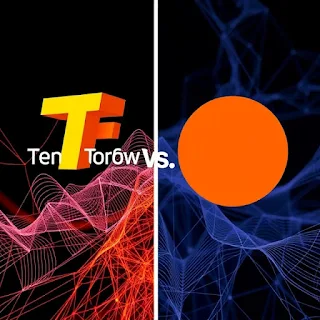TensorFlow vs. PyTorch: A Comprehensive Guide for AI Developers
In the world of artificial intelligence (AI) and machine learning, choosing the right deep learning framework is crucial for successful project implementation. **TensorFlow** and **PyTorch** are two of the most widely used deep learning frameworks in the industry, each with its own strengths, limitations, and community support. In this blog post, we'll dive into the key differences between TensorFlow and PyTorch, comparing their ease of use, flexibility, performance, and popularity to help you make an informed decision on which framework to use for your next AI project.
1. What is TensorFlow?
Developed by Google Brain, **TensorFlow** is one of the most popular deep learning frameworks, known for its scalability and production-readiness. TensorFlow supports a wide range of machine learning tasks, including deep learning, reinforcement learning, and more. It provides a comprehensive ecosystem that includes tools for model building, training, deployment, and monitoring, making it a go-to choice for both research and production environments.
Key Features of TensorFlow:
- Scalability: TensorFlow is designed to handle large-scale machine learning tasks and supports deployment across multiple devices and platforms.
- Production Ready: TensorFlow offers robust tools for deployment, including TensorFlow Lite for mobile devices and TensorFlow.js for web applications.
- Extensive Documentation and Community: TensorFlow has extensive documentation and a large, active community, which makes it easier to find solutions to issues and gain support.
- TensorFlow Extended (TFX): A set of libraries and tools designed for deploying production machine learning pipelines.
Common Use Cases for TensorFlow:
- Computer vision (image recognition, object detection)
- Natural language processing (NLP) and text generation
- Reinforcement learning
- Deploying models in production environments
2. What is PyTorch?
Developed by Facebook’s AI Research lab (FAIR), **PyTorch** has gained significant traction in the AI community due to its dynamic computation graph and ease of use. PyTorch is particularly popular for research and development because of its intuitive design and flexibility. Unlike TensorFlow's static computation graph, PyTorch uses a dynamic graph, which makes it easier to experiment with new models and techniques.
Key Features of PyTorch:
- Dynamic Computation Graph: PyTorch uses dynamic (eager) execution, which allows for more flexibility during the model-building process, making it easier to debug and modify the code.
- Ease of Use: PyTorch’s syntax and APIs are considered more Pythonic and user-friendly, making it a popular choice for researchers and developers who need quick prototyping.
- Seamless Integration with Python: PyTorch integrates seamlessly with Python libraries like NumPy and SciPy, which makes it easy to incorporate additional functionalities into your models.
- Growing Community: PyTorch has a rapidly growing community and is becoming increasingly popular in both academia and industry.
Common Use Cases for PyTorch:
- Academic research and experimentation
- Natural language processing (NLP)
- Computer vision (image segmentation, object detection)
- Prototyping new machine learning algorithms
3. TensorFlow vs. PyTorch: Key Differences
While TensorFlow and PyTorch are both highly capable deep learning frameworks, they differ in several key areas:
- Computation Graph: TensorFlow uses a static computation graph, meaning that you must define the entire model upfront before running it. In contrast, PyTorch uses dynamic computation, allowing you to define and modify the model as you go.
- Ease of Use: PyTorch is considered more intuitive and easier to use for beginners and researchers, with a more Pythonic interface. TensorFlow, while powerful, can be more challenging to work with due to its more complex syntax, although TensorFlow 2.0 has made significant improvements.
- Performance: TensorFlow tends to be faster for production environments, especially when scaling across multiple GPUs and CPUs, thanks to its optimizations for deployment. PyTorch, however, is also highly performant and can be equally fast in research and experimentation.
- Deployment: TensorFlow offers more robust tools for deploying models to production, including TensorFlow Serving, TensorFlow Lite (for mobile), and TensorFlow.js (for the web). PyTorch, while it has improved in this area, is typically used more for research and prototyping.
- Community and Ecosystem: Both frameworks have strong communities and growing ecosystems. TensorFlow has a longer history and a larger community, while PyTorch has seen rapid growth in recent years, particularly in academia.
4. When to Use TensorFlow vs. PyTorch?
Choosing between TensorFlow and PyTorch depends on the nature of your project and your development environment:
- Use TensorFlow: If you're working on large-scale production systems, need robust deployment tools, or are using a cloud environment, TensorFlow is likely a better fit. It's ideal for projects that require high scalability and stability in production environments.
- Use PyTorch: If you're focused on research, experimentation, or building prototypes, PyTorch is a great choice. Its flexibility and ease of use make it ideal for testing out new ideas and rapidly iterating on models.
Conclusion
In conclusion, both **TensorFlow** and **PyTorch** are excellent deep learning frameworks, each excelling in different areas. **TensorFlow** is better suited for production and large-scale applications, while **PyTorch** shines in research and development with its intuitive interface and dynamic computation graph. Ultimately, the choice between TensorFlow and PyTorch depends on the specific needs of your project, your familiarity with the framework, and whether you prioritize flexibility or production readiness.

